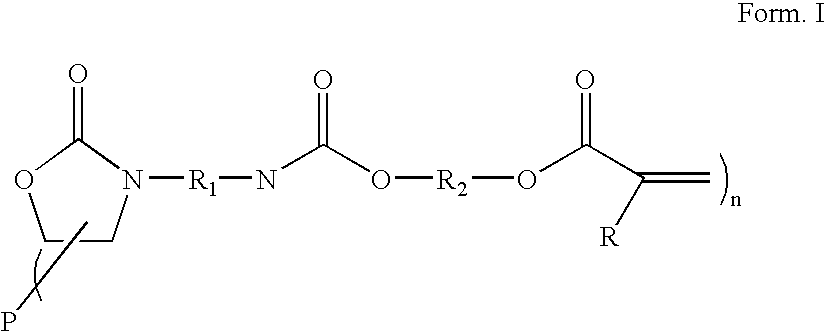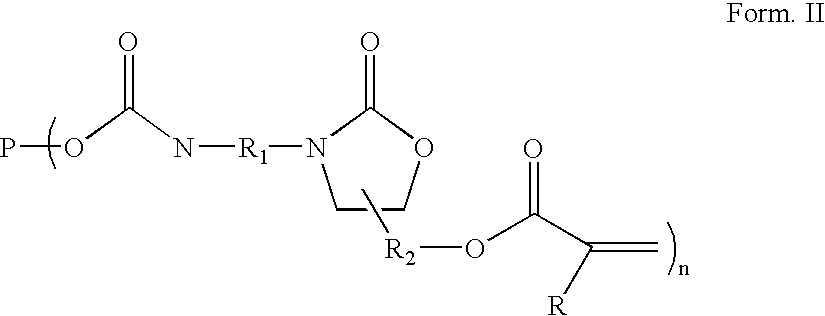Radiation curable coating composition
a technology of coating composition and curable coating, which is applied in the direction of coatings, emulsion paints, polyurea/polyurethane coatings, etc., can solve the problem of the cure speed of coatings and/or binders, and the limit on the speed of production lines, etc., and achieves good adhesion and high curing speed
- Summary
- Abstract
- Description
- Claims
- Application Information
AI Technical Summary
Benefits of technology
Problems solved by technology
Method used
Image
Examples
example i
Synthesis of Oxazolidone Urethane Acrylate Functional Polytetrahydrofuran (polyTHF) (Compound A)
[0150] A 500 ml glass reactor equipped with a stirrer, dry air inlet, reflux condensor and dropping funnel was charged with 102 g 4,4,methylene bis (cyclohexyl isocyanates) (HMDI), 1.1 g tri butyl phosphine oxide, 0.3 g lithium bromide and 0.3 g bis(2,4-di-t-butyl-phenyl) pentaerythritol diphosphite (Ultranox 626™ General Electric). The mixture was stirred at 80° C. until all the lithium bromide was dissolved after which the temperature was raised to 130° C. 152 g polyTHF diglycidyl ether (Mn 780) was added at 130° C. at a rate of +500 ml / hour. After the addition was completed the reaction mixture was kept at 130° C. for 1 hour, after which 0.3 g dibutyl-hydroquinone (DBH) and 0.3 g di butyl tin dilaurate (DBTDL) was added followed by decreasing the reaction temperature to 80° C. Dry air was purged trough the reaction mixture and 45 g 2-hydroxy ethyl acrylate (HEA) was added slowly, unde...
example ii
Synthesis of Oxazolidone Urethane Acrylate Functional polyTHF (Compound B)
[0153] A 300 ml glass reactor equipped with a stirrer, dry air inlet, reflux condensor and dropping funnel was charged with 61 g HMDI, 0.7 g tri butyl phosphine oxide, 0.2 g lithium bromide and 0.3 g Ultranox 626™. The mixture was stirred until all the lithium bromide was dissolved at 80° C. after which the temperature was raised to 130° C. 121 g polyTHF diglycidyl ether (Mn 780) was added at 130° C. at a rate of ±500 ml / hour. After the addition was completed the reaction mixture was kept at 130° C. for 1 hour, after which 0.2 g dibutyl-hydroquinone (DBH) and 0.2 g DBTDL was added followed by decreasing the reaction temperature to 80° C. Dry air was purged trough the reaction mixture and 18 g HEA was added slowly, under dry air bubbling through the reaction mixture, at such a rate that the temperature was kept below 100° C. After the addition was complete the reaction mixture was kept at 80° C. for 1 hour aft...
example iii
Synthesis of Oxazolidone Urethane Acrylate Functional Polypropylene Glycol PPG (Compound C)
[0156] A 300 ml glass reactor equipped with a stirrer, dry air inlet, reflux condensor and dropping funnel was charged with 58 g HMDI, 0.7 g tri butyl phosphine oxide, 0.2 g lithium bromide and 0.2 g Ultranox 626™. The mixture was stirred until all the lithium bromide was dissolved at 80° C. after which the temperature was raised to 130° C. 105 g polypropylene glycol diglycidyl ether (Mn 710) was added at 130° C. at a rate of ±500 ml / hour. After the addition was completed the reaction mixture was kept at 130° C. for 1 hour, after which 0.2 g dibutyl-hydroquinone (DBH) and 0.2 g DBTDL was added followed by decreasing the reaction temperature to 80° C. Dry air was purged trough the reaction mixture and 17 g HEA was added slowly, under dry air bubbling through the reaction mixture, at such a rate that the temperature was kept below 100° C. After the addition was complete the reaction mixture was...
PUM
| Property | Measurement | Unit |
|---|---|---|
| Linear density | aaaaa | aaaaa |
| Pressure | aaaaa | aaaaa |
| Time | aaaaa | aaaaa |
Abstract
Description
Claims
Application Information
 Login to View More
Login to View More - R&D
- Intellectual Property
- Life Sciences
- Materials
- Tech Scout
- Unparalleled Data Quality
- Higher Quality Content
- 60% Fewer Hallucinations
Browse by: Latest US Patents, China's latest patents, Technical Efficacy Thesaurus, Application Domain, Technology Topic, Popular Technical Reports.
© 2025 PatSnap. All rights reserved.Legal|Privacy policy|Modern Slavery Act Transparency Statement|Sitemap|About US| Contact US: help@patsnap.com



